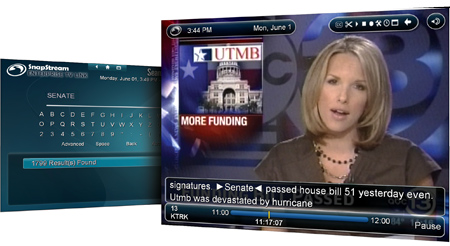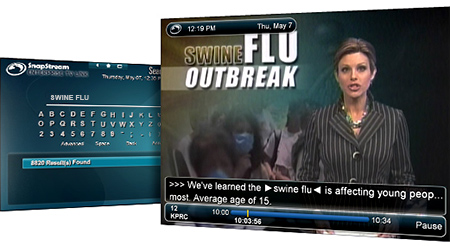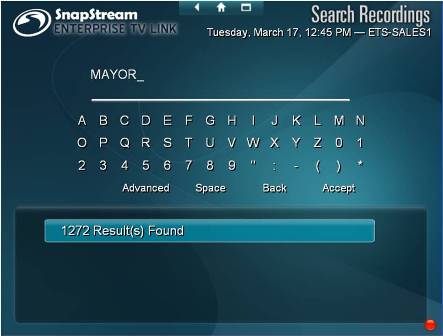Pixsooz/Shutterstock
Loudness Compliance and the CALM Act: What You Need to Know
Watch SnapStream's CEO, Rakesh Agrawal, on Bloomberg TV
Are you curious about the present and future plans of SnapStream? Who better to ask than the CEO and Founder himself!
“Last Week Tonight with John Oliver” Joins SnapStream’s Family of Talk Shows
First and foremost, let me start by saying, “Welcome to the family “Last Week Tonight,” John Oliver, and the entire team of producers, editors, and show writers!”
In case you haven’t heard, “Last Week Tonight with John Oliver” selected SnapStream’s TV recording and search technology to help build the TV clips and content that will be used on the show. (Here is the press release)
Need an example? Next time you tune in (the show airs every Sunday on HBO) watch for the pop-up TV clips that John Oliver references throughout the show. Those clips are pulled using SnapStream!
How They Use SnapStream
With SnapStream’s technology, the team at “Last Week Tonight” is able to quickly search and aggregate mass amounts of current, often obscure, TV content from worldwide sources. This technology, along with John Oliver’s undeniable genius for political satire, is the perfect equation for comedic gold.
See new SnapStream 6.0 at Content & Communications World
Next week, we're heading to the Big Apple to showcase our TV monitoring technology at Content and Communications World (CCW). Many broadcast folks refer to this hallmark event as the NAB of the East Coast. Since NAB in April, SnapStream's engineers have been diligently working to launch SnapStream 6.0 and tons of new capabilities.
Whether you're a current user or considering SnapStream for the first time, you'll find that everything in the new version helps to enrich your production workflow for recording, searching, clipping and repurposing TV content.
The Worldview of News Satire TV Shows, like The Daily Show
If you've heard of SnapStream's TV monitoring technology, you've likely heard The Daily Show with Jon Stewart and The Colbert Report mentioned in the same breath. While we can't take credit for Jon Stewart's acerbic on-air personality or Stephen Colbert's deadpan delivery, we can say one thing: we are the television search technology behind the news-driven humor.
Yup, our very own closed-captioning search technology is at work on the TV production sets of both of these Emmy-award-winning shows. For this reason, we at SnapStream have a special place in our hearts for the TV genre of news satire, or "fake news." So, this got us thinking, when did this trend come into vogue? Are there mock newscast shows in other countries? Who are The Daily Show equivalents worldwide? It turns out, The Daily Show's international impact is pretty astounding.
SnapStream makes its official European debut with DVB-T and PAL! #IBC11
How Elected Officials Enhance their Media Monitoring Efforts
City of Austin cuts TV montoring costs with SnapStream
Tracking TV Mentions of Your Government Agency
Governments use SnapStream to monitor television for a variety of reasons. In most government uses, it’s the PIOs who are using SnapStream to keep themselves, and thus the public, informed about issues that relate to the governing of the city and the reaction of the media to those issues. It is the responsibility of the PIOs to track events, issues and people relating to their specific department/agency.
What is SnapStream? There's an unlimited amount of video content out there: 24/7 news channels, breaking news events, sports, talk shows, awards galas, entertainment shows, and so much more.
SnapStream makes a real-time news and media search engine that makes it fast and easy to find the video moments that support our customers telling great stories.
Posts by Topic
- General TV Search (165)
- Technology Development (28)
- Support Corner (26)
- Television and Film Production (26)
- Social TV (24)
- Broadcast Monitoring (23)
- TV Trends (23)
- Tradeshows (23)
- news (23)
- Government (19)
- Release (19)
- Fun (16)
- Journalism (16)
- Politics (16)
- TV search (16)
- Education (14)
- Newsmedia (13)
- new product (13)
- updates (13)
- Entertainment (11)
- Video Clips (10)
- broadcast compliance (10)
- broadcast monitoring and compliance (10)
- social engagement (10)
- Twitter TV clips (8)
- Local TV stations (7)
- TV Monitoring/PR (7)
- Meet Team SnapStream (6)
- SnapStream News (6)
- Social in Sports (6)
- social sharing (6)
- livecut (5)
- City Government (4)
- International (4)
- Sports (4)
- media monitoring (4)
- snappytv (4)
- thought leadership (4)
- Addressable Advertising (3)
- CALM Act (3)
- Case Study (3)
- Context (3)
- Facebook TV clips (3)
- LKFS (3)
- Resources (3)
- SnapStream Cloud (3)
- SnapStream Enterprise (3)
- Streams (3)
- TV closed-captioning search (3)
- avoidance (3)
- clipping (3)
- ditigal (3)
- loudness compliance (3)
- misinformation (3)
- snappytv alternative (3)
- snappytv replacement (3)
- television monitoring (3)
- 8.3 (2)
- 8.5 (2)
- Advertising (2)
- How-to (2)
- Influencers (2)
- Jschool (2)
- News Satire (2)
- Pew Research (2)
- Radio Production (2)
- SnapStream (2)
- SnapStream Advanced (2)
- The Colbert Report (2)
- The Daily Show with Jon Stewart (2)
- Training (2)
- blog post (2)
- covid (2)
- covid-19 (2)
- election (2)
- live clipping (2)
- live video (2)
- loudness monitoring (2)
- media technology (2)
- trust (2)
- veracity (2)
- 8.1 (1)
- 8.2 (1)
- 9.1 (1)
- 9.2 (1)
- 9.3 (1)
- 9.4 (1)
- AEJMC (1)
- Barack Obama (1)
- Bloomberg TV (1)
- Fake News (1)
- H.264 (1)
- HLS (1)
- Hockey (1)
- Holiday (1)
- Houston tech (1)
- ISTE (1)
- Infotainment (1)
- International News Satire TV Shows (1)
- Lebron James (1)
- Libary (1)
- Local TV News (1)
- MVPD (1)
- MVPDs (1)
- Market Makers (1)
- Merging (1)
- Multi-viewer (1)
- NHL (1)
- Nancy Jennings (1)
- News Satire TV Shows in Other Countries (1)
- ONA21 (1)
- PIO (1)
- Playlists (1)
- Quality Assurance (1)
- RTMP (1)
- Reviewing Clips (1)
- STB (1)
- Satirical TV Shows (1)
- SnapStream 9.3 (1)
- SnapStream 9.4 (1)
- SnapStream 9.5 (1)
- SnapStream Interview (1)
- SnapStream Server (1)
- St. Louis Blues (1)
- Summer News (1)
- Super Bowl Commercials (1)
- Switch and Save (1)
- Uploading (1)
- Volicon (1)
- Webplayer (1)
- World Cup (1)
- Zoom (1)
- accessibility in broadcast (1)
- blogging (1)
- broadcast accessibility (1)
- broadcast tv accessibility (1)
- cable networks (1)
- closed captioning (1)
- closed captioning compliance (1)
- closed captions (1)
- content analysis (1)
- cto (1)
- customer appreciation (1)
- customers (1)
- debates (1)
- deep (1)
- deepfake (1)
- director of technology (1)
- edtech (1)
- encoder (1)
- explainer (1)
- fake (1)
- fan engagement (1)
- fire department (1)
- free server maintenance (1)
- innovation (1)
- live event (1)
- local tv (1)
- managed tv (1)
- media (1)
- monetization (1)
- online (1)
- podcast (1)
- police department (1)
- press release (1)
- public information officer (1)
- ratings (1)
- recording (1)
- remote work (1)
- set-top box (1)
- sharing (1)
- snapstream 9.6 (1)
- transmission engineering (1)
- tv alerts (1)
- tv networks (1)
- watchespn app (1)
- webinar (1)
- workspace (1)









